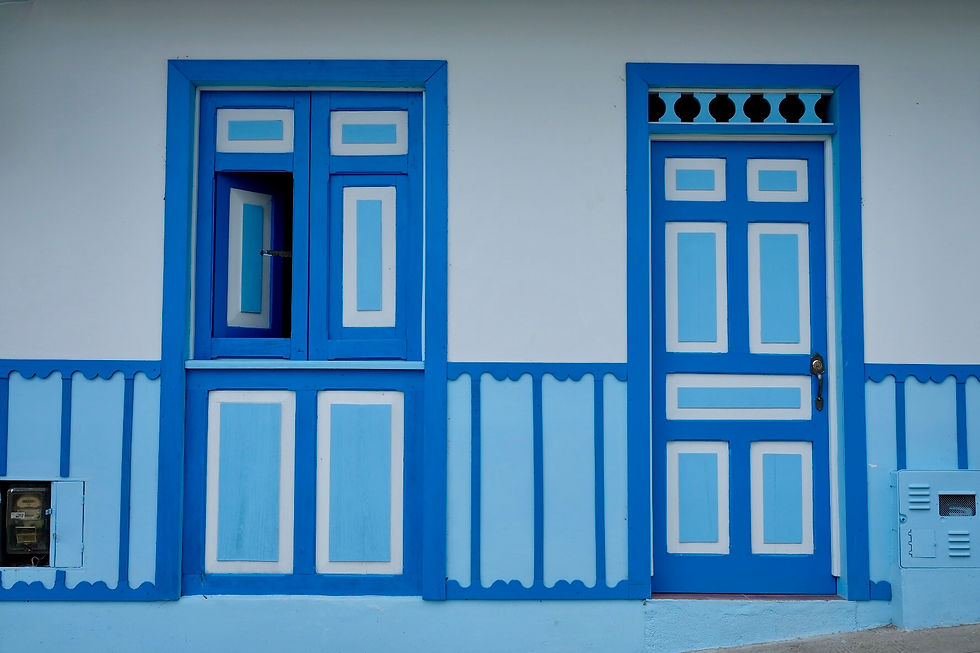Colombia | Finally at the source
- Marta & Oskar
- Jan 6, 2019
- 4 min read
Make sure you put the below song on when reading the post. You are reading about Colombia after all - music is a must! Original is by immortal Carlos Vives, the guy dressed in all white.
My love affair with coffee finally reached its true source - Zona Cafetera in the Colombian Andes. It was here, in a tiny village of Pijao hidden away from the main attractions of the region, that we learned everything about coffee (and got over-caffeinated along the way). While I learned a lot about what goes into making coffee, what I took out from the day turned out to be quite different altogether. But let me tell you about the day first.
It began with a ride through coffee plantations at the back of an old Willy Jeep - still the best car to move around the rugged and muddy Pijao hills. Fittingly for Colombia, the music was on full blast. Thankfully, it was not Shakira lauding truthful hips but rather a local band taking about their love for paisa, the country. Perfect background
30 minutes later, we stopped to meet the owner of the plantation - Don Leon. He looked exactly how I imagined a coffee farmer - he was small and energetic, with a rumpled hat, checkered shirt, rubber boots for walking among the coffee trees and had a big basket attached to his hips for collecting beans. Soon we learnt that his father, grandfather, great-grandfather and great-great-grandfather (you get the gist) were also coffee growers. His original home was in the Cauca region, but he moved to Zona Cafetera to escape the drug trafficking problems that were making life in his village unbearable. Yet another proof that at some stage this ‘business’ had a negative influence on everyone in the country.
We entered his house to see how coffee is processed, learn about different varieties and see how beans are dried and roasted. Don Leon produces three types of beans. Specialty which are the best and the most expensive ones, premium which in fact are not very premium and the worst quality cooperative beans, which is basically everything else, often rotten and of uneven size. The surprise was that the last type are the beans often bought by big cafe chains, like Starbucks globally or Juan Valdez in Latin America. We were not allowed to step on specialty beans in the drying area but were encouraged to jump all over cooperative beans. Growers in the Zona Cafetera clearly have little respect for Starbucks. In the meantime, there was plenty of time to taste the coffee that Don Leon was most proud of. In the heat of the moment and without thinking of how we will travel with it for the remaining 2 months of our trip, we bought 3 kg of Don Leon coffee, all branded and nicely packaged.
After lunch, we headed back to Pijao. There, we visited a typical countryside coffee shop. It is as far away from swanky Sydney cafes as you can imagine. At the same time, the charming ’60s decor, cool 100 years old coffee machine (which made terrible coffee) and photogenic paisas (countrymen) would make any hipster happy and instantly Insta-famous.
Next stop was a cafe run by another local farmer, Alejandro, who similarly to Don Leon was trying to diversify his business and look for more margin. Here all the hipsters of Sydney or Warsaw would be completely blown away. Alejandro could teach them to prepare their coffee according to all third wave methods imaginable - from Aeropress, Chemex to V60 and Kalita Wave. We sat on fashionable poufs made out of hessian bags and carefully measured the exact amount of coffee needed to make a perfect cup. Later, buzzing from all the caffeine, we moved on to a local cooperative. Its role is to buy coffee from farmers and then sell it to Federacion Nacional de Cafeteros de Colombia. Here we learnt the sad truth. The price of coffee beans on the global markets is falling rapidly. Unfortunately, both the government and big coffee companies are doing nothing or very little to counteract this situation. Because of this farmers are often forced to sell the product for less than it costs them to make it.
I must admit that I thought I knew a lot about coffee before but the whole day spent hanging out with locals who live and breathe coffee did open my eyes. I experienced first hand how much love, passion, and work goes into preparing the raw product for my flat white. I met the people, I saw how they live. It is a happy life, but because of the price of the beans, it is not free of worry. Suddenly, paying close to $4 for a cup without thinking much made me feel very uneasy. How much of this money really does get back to the source? The way to help, I guess, is similar to where food is involved - as often as we can, we should buy our lattes from smaller cafes which can tell where the beans come from. Fair trade and UTZ certifications are also a good sign. If it is a bigger supplier (like Campos or Allpress in Australia) check their ethos, but be careful about 'green washing'. Avoid Starbucks and other similar chains for the good of the farmers and for the sake of your own tastebuds (unless you want to taste coffee that we literally walked all over!).






















Comments